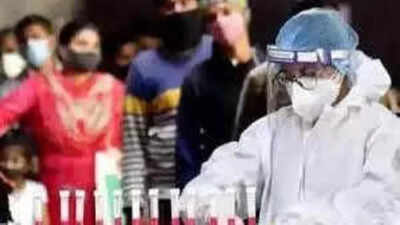Top Searches
- News
- City News
- kolkata News
- West Bengal: New Covid cases cross 1,000 mark since February
West Bengal: New Covid cases cross 1,000 mark since February

The Covid graph in Bengal continues to rise unabated with daily positive cases.(Representative image)
KOLKATA: The Covid graph in Bengal continues to rise unabated with daily positive cases reaching the four-digit figure on Wednesday after almost five months. The positivity rate, too, spiked above 10% for the first time in more than five months. On Wednesday, the state logged 1,424 new Covid cases and a positivity rate of 12.7%. Health experts cautioned the public to wear masks in public places and not to delay their vaccine booster dose.
The last time Bengal logged four-digit cases was on February 5, when the third wave was on. It was the receding phase of the third wave and the numbers had already started dropping sharply. For close to three months after that, between March 12 and June 9, Bengal had logged new positive cases in two digits. "The numbers are rising but in terms of hospital care requirement, they remain low since the infection is mostly causing a mild disease, like influenza. All our hospital infrastructure is ready in case more infected need hospital care," said director of health services Siddhartha Niyogi. On Wednesday, 260 Covid patients were under treatment at different hospitals, while 5,625 infected were in home isolation.
The state's Global Advisory Board for Covid-19 has also sounded caution, pointing out that July and part of August could be crucial for Bengal.
Health officials said a majority of the Covid cases were reported from Kolkata and North 24 Parganas. "The actual number of infected people could be much higher than what is being reflected as many are not going for tests. But given the nature of the infection, this surge might not be as bad as the previous waves. It is high time people wore their masks while stepping out as the practice can restrict the chain of transmission to a large extent," said infectious diseases specialist Sayan Chakrabarty of AMRI Hospitals, Dhakuria.
During the third wave, the positivity rate in Bengal had shot up to 37.3% on January 10. But the decline was also as swift as that of the surge. The rate dropped to below 10% within two weeks and stood at 9.5% on January 23. It plunged to below 1% by February 18 and remained there till June 5. "Case surge is likely to continue in coming days. Though there is no need to get frightened but we need to be aware and should stick to Covid-appropriate behaviour, especially in gatherings or on public transport. It is actually in our hand to check the rapid spread of the novel coronavirus in the community," said public health specialist Anirban Dalui, attached with Swasthya Bhawan.
FOLLOW US ON SOCIAL MEDIA
FacebookTwitterInstagramKOO APPYOUTUBE

Start a Conversation
end of article









